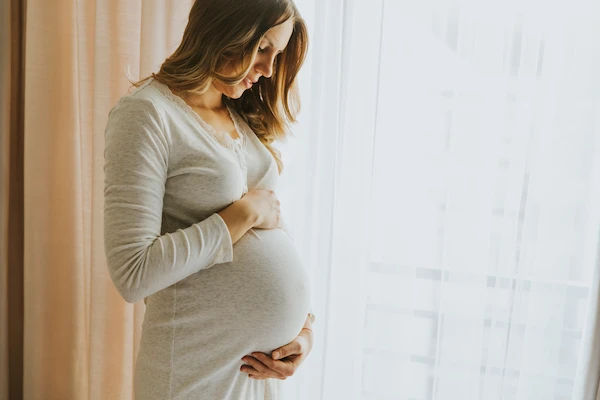Guide to Weeks Pregnant
Discover your pregnancy week by week, from conception to full term. Learn fetal development, maternal symptoms, screenings, nutrition, and key milestones for a healthy pregnancy.


Pregnancy unfolds in weeks, and each of those weeks brings meaningful changes for you and your baby. Whether you’re 5 weeks or 35 weeks pregnant, knowing what to expect—and when—helps you make confident decisions about tests, symptoms, nutrition, and birth planning. This guide walks you through pregnancy weeks step by step: how weeks are counted, what’s happening in your body and your baby’s development, which screenings are offered at specific weeks, and how to care for your physical and emotional health along the way. You’ll also find practical timelines like the 20 weeks anatomy scan, the 24–28 weeks glucose test, and the 36–37 weeks group B strep swab, plus clear red flags that mean it’s time to call a doctor. If a symptom lasts more than a couple of weeks or you’re worried, you’ll see where consulting a clinician is recommended. Let’s make the weeks work for you—with timely tips, evidence-based guidance, and reassurance at every stage.
How Pregnancy Weeks Are Counted and Your Due Date?
Pregnancy is conventionally dated from the first day of your last menstrual period (LMP), not the date of conception.
This standard makes it easier to compare weeks across pregnancies and guides timing for tests. Due date is often
estimated using Naegele’s rule: add 280 days (40 weeks) to your LMP. Early ultrasounds may adjust your estimated
due date when measured crown–rump length doesn’t align with LMP, as early ultrasound dating is most accurate.
Knowing your exact weeks pregnant helps you schedule time-sensitive screenings, such as nuchal translucency at about
12 weeks and the 20 weeks anatomy scan.
Trimester breakdown by weeks
- First trimester: 0–13 weeks
- Second trimester: 14–27 weeks
- Third trimester: 28–40+ weeks
References to milestones such as viability around 24 weeks, Tdap at 27–36 weeks, or post-term monitoring after 41 weeks follow this framework.
When dates change and why it matters
If your first-trimester ultrasound differs significantly from your LMP, your provider might revise the due date. This
affects counseling about preterm risk (before 37 weeks), scheduling tests such as glucose screening at 24–28 weeks, and
deciding when to consider induction (often by 41 weeks). Early ultrasound is particularly valuable if cycles are irregular.
Weeks 1–4: The Earliest Stage
See the growth of a foetus from week 1 to 4:
Conception and implantation
Weeks 1–2 are counted before conception. Around week 3, fertilization occurs and the embryo travels to the uterus. By
week 4, implantation typically completes, and hCG begins to rise. Some people note implantation spotting or mild
cramping.
Early symptoms and testing
By the end of week 4 or after a missed period, home pregnancy tests often detect hCG. Early symptoms can include
breast tenderness, fatigue, and subtle changes in appetite. Morning sickness may begin but usually peaks later.
Folic acid and early lifestyle steps
Folic acid (400–800 mcg daily) started before conception and continued through early weeks reduces neural tube
defects. Avoid alcohol and smoking and review medications with your clinician. Early weeks are also important for
coordinating care if you have conditions like diabetes or thyroid disease. Home collection for early labs like TSH,
vitamin D, and HbA1c can be convenient.
Weeks 5–8: First Trimester in Full Swing
See the growth of a foetus from week 5 to 8:
Embryo development and heartbeat
Around 5–6 weeks, a gestational sac and yolk sac may be seen by ultrasound; by 6–7 weeks, cardiac activity is often
detectable. The embryo’s neural tube is forming, so folate remains critical.
Nausea, fatigue, and safe self-care
Nausea and vomiting can intensify due to hormonal shifts, peaking later in the first trimester. Small, frequent meals,
ginger, vitamin B6, and hydration can help. Persistent vomiting beyond 24 hours requires medical evaluation. Early
weeks are also ideal for reviewing safe medications and work adjustments if fatigue is significant.
Early blood tests and first visit
The first prenatal visit often occurs between 6 and 10 weeks. Baseline labs may include blood count, blood type and Rh
status, infectious disease screening, and thyroid tests if indicated. If Rh-negative, anti-D prophylaxis is discussed later.
Weeks 9–13: Screening Choices and First Milestones
See the growth of a foetus from week 9 to 13:
Nuchal translucency and NIPT windows
Between 11 and 13+6 weeks, a nuchal translucency ultrasound can estimate risk for chromosomal conditions, often
combined with blood tests. Noninvasive prenatal testing (NIPT) can be done as early as 10 weeks to screen for
trisomies.
Miscarriage risk and reassurance scans
Risk of miscarriage decreases after the first trimester. Spotting or mild cramping may prompt repeat scans. Heavy
bleeding or severe pain requires urgent care.
Travel, exercise, and work adjustments
Light to moderate exercise is usually safe. Routine travel is typically acceptable for uncomplicated pregnancies, with
hydration and medical info on hand. Use weeks 10–13 to finalise genetic screening plans before the windows close.
Consult Top Specialists Here
Weeks 14–20: Hitting Your Stride
See the growth of a foetus from week 14 to 20:
Quickening and anatomy changes
Many feel first fetal movements between 16 and 20 weeks. Energy levels often rise, appetite stabilizes, and nausea
usually fades.
18–22 weeks anatomy scan
Mid-pregnancy ultrasound examines the baby’s organs, placenta, amniotic fluid, and growth. If the placenta is low, a
repeat scan may be scheduled.
Sleep positions and symptom shifts
Side-sleeping, preferably left-side, optimizes blood flow and reduces strain. Heartburn can increase; small meals and
elevating the head of the bed can help.
Weeks 21–27: Late Second Trimester
Growth spurt and fundal height
Fundal height measurements track baby’s growth. Kicks and fetal activity become more distinct.
24–28 weeks glucose screening
Gestational diabetes screening occurs between 24 and 28 weeks. Home collection for tests like HbA1c can be arranged
if indicated.
Planning leave and travel limits
Many airlines restrict flying after 36 weeks. Weeks 21–27 are often the last comfortable travel period for low-risk
pregnancies. Use this time to choose a pediatrician and review maternity leave paperwork.
Weeks 28–36: Early Third Trimester Prep
See the growth of a foetus from week 28 to 36:
Tdap timing, Rhogam at 28 weeks
Tdap is recommended between 27 and 36 weeks. Rh-negative individuals usually receive anti-D at 28 weeks.
Fetal movement and kick counts
Daily awareness of fetal movements is encouraged. Patterns matter more than exact numbers. A decrease in
movements for several hours warrants immediate contact with a clinician.
GBS testing, birth preferences
Group B strep swab occurs around 36–37 weeks. Finalize hospital bag items, childcare, and postpartum support.
Weeks 37–42: Full-Term, Labor Signs, and Post-Dates
See the growth of a foetus from week 37 to 42:
Signs of labor and when to go
At 37–40 weeks, signs include pelvic pressure, back ache, and Braxton Hicks. True labor involves regular, intensifying
contractions, rupture of membranes, or bloody show. Follow your provider’s plan for hospital visits.
Induction considerations at/after 41 weeks
Term is 37–41 weeks; post-term is 42 weeks. Induction around 41 weeks is often discussed to reduce risks.
Post-term monitoring and outcomes
After 41 weeks, monitoring includes nonstress tests and amniotic fluid checks. Reduced fetal movements require urgent
evaluation.
Tests and Scans by Weeks: A Practical Timeline
Here’s a guide on when to get the test and scans when you’re pregnant:
First trimester labs and optional screens
0–13 weeks: Baseline labs such as blood type, Rh, CBC, and infectious screens. Optional genetic screens include NIPT
and nuchal translucency scans. CVS may be offered selectively.
Second trimester detailed ultrasound
18–22 weeks: Anatomy scan. Quad screen may be done between 15–22 weeks as an alternative.
Third trimester monitoring
24–28 weeks: Glucose screen. 27–36 weeks: Tdap vaccine. 28 weeks: Rhogam if Rh-negative. 36–37 weeks: GBS
testing. High-risk pregnancies may require additional monitoring.
Nutrition, Weight Gain, and Supplements by Weeks
Trimester targets and macro balance
Weight gain depends on pre-pregnancy BMI. Early weeks focus on consistent nutrition despite nausea. Later weeks
require nutrient-dense foods to meet increased iron and calcium needs.
Iron, calcium, DHA, and vitamin D
Iron supports blood volume; calcium and vitamin D support bone development; DHA aids brain and eye development. Labs can be arranged via home collection.
Managing nausea and heartburn
Nausea peaks by weeks 8–12, heartburn may worsen after 20 weeks. Small, frequent meals and elevating the head of
the bed can help. Persistent symptoms beyond two weeks require clinician evaluation.
Common Symptoms by Weeks and When to Call a Doctor
Red flags and emergency signs
Seek urgent care for heavy bleeding, severe abdominal pain, fever, persistent headache, vision changes, sudden
swelling, chest pain, or reduced fetal movements after 28 weeks.
Persistent symptoms and support
If nausea, constipation, or mood disturbances persist, consult a clinician. Online consults or in-person visits can ensure
timely care.
How Apollo 24|7 can help
Online consults, safe medication guidance, nutrition plans, and home lab collection for thyroid, HbA1c, and vitamin D
are available.
Special Considerations by Weeks: Twins, AMA, and Preexisting Conditions
More frequent scans and growth checks
Multiples require more frequent ultrasounds, especially after 20 weeks. Travel may need earlier restriction.
Aspirin, thyroid, and glucose oversight
Low-dose aspirin may reduce preeclampsia risk. Thyroid conditions may need medication adjustments. Diabetes
requires close monitoring.
Travel and work adjustments
Late second trimester may require ergonomic adjustments and standing breaks. Risk-specific calendars help plan scans
and lifestyle decisions.
Emotional Health by Weeks and Partner Support
See how mood shifts and need emotional support:
Mood shifts and anxiety
Hormonal changes and physical discomfort can cause anxiety and low mood. Persistent issues beyond two weeks
warrant clinician consultation.
Sleep, mindfulness, and support plans
Side-sleeping, consistent wind-down routines, and brief mindfulness exercises can support well-being throughout
pregnancy.
Partner weekly checklists
Partners can track key milestones like the 20 weeks scan, 24–28 weeks glucose test, 36–37 weeks GBS swab, and
hospital bag packing.
Baby’s Development by Weeks: Quick Snapshot Guide
Let’s have a look at the developments of a baby:
Size comparisons and key structures by trimester
First trimester: Organ foundations and heartbeat (~6–7 weeks). Second trimester: Rapid growth, movement, developing
senses. Third trimester: Fat accumulation, brain and lung maturation.
Viability and lung maturation
Around 24 weeks, survival outside the womb becomes more likely with intensive care. Antenatal steroids may be given
if preterm birth is expected.
40 weeks and beyond: finishing touches
Final weeks involve breathing practice and fat accumulation. Placental support continues, with monitoring guiding
post-term decisions.
Consult Top Specialists Here
Consult Top Specialists Here

Dr. Sreeparna Roy
Obstetrician and Gynaecologist
8 Years • MBBS , MS (OBSTETRICS & GYNAECOLOGY), Fellowship in Infertility, Endoscopy & Ultrasonography), Fellowship in Laparoscopy & Hysteroscopy,DRM
Kolkata
Dr Utsa Basu Clinic, Kolkata

Dr. Sai Lakshmi Daayana
Gynaecological Oncologist
18 Years • MBBS, MRCOG
Hyderabad
Apollo Hospitals Jubilee Hills, Hyderabad
(225+ Patients)

Dr. Revathi S Rajan
Obstetrician and Gynaecologist
24 Years • MBBS, DGO, DNB.FFMM
Bengaluru
Apollo Clinic, JP nagar, Bengaluru

Dr. Rupam Manna
Radiation Specialist Oncologist
4 Years • MBBS MD(RADIO THERAPY)
Barasat
Diab-Eat-Ease, Barasat
Dr. Navin Srinivasan
Gynaecological Oncologist
9 Years • MBBS, MS DNB(OBS-GYNAE), MCH (GYNAE ONCOLOGY)
Bengaluru
Apollo Clinic Mahadevapura, Bengaluru
Consult Top Specialists Here

Dr. Sreeparna Roy
Obstetrician and Gynaecologist
8 Years • MBBS , MS (OBSTETRICS & GYNAECOLOGY), Fellowship in Infertility, Endoscopy & Ultrasonography), Fellowship in Laparoscopy & Hysteroscopy,DRM
Kolkata
Dr Utsa Basu Clinic, Kolkata

Dr. Sai Lakshmi Daayana
Gynaecological Oncologist
18 Years • MBBS, MRCOG
Hyderabad
Apollo Hospitals Jubilee Hills, Hyderabad
(225+ Patients)

Dr. Revathi S Rajan
Obstetrician and Gynaecologist
24 Years • MBBS, DGO, DNB.FFMM
Bengaluru
Apollo Clinic, JP nagar, Bengaluru

Dr. Rupam Manna
Radiation Specialist Oncologist
4 Years • MBBS MD(RADIO THERAPY)
Barasat
Diab-Eat-Ease, Barasat
Dr. Navin Srinivasan
Gynaecological Oncologist
9 Years • MBBS, MS DNB(OBS-GYNAE), MCH (GYNAE ONCOLOGY)
Bengaluru
Apollo Clinic Mahadevapura, Bengaluru
More articles from pregnancy
Frequently Asked Questions
1) How many weeks pregnant am I if I don’t know my LMP?
Early ultrasound dating is most accurate to estimate weeks and your due date. If you’re unsure, ask for a scan to determine gestational age. Related term: how many weeks pregnant am I calculator.
2) What happens at 12 weeks of pregnancy?
Around 12 weeks, many finish first-trimester screening (NT ultrasound with bloodwork) and see miscarriage risk decline. Nausea often improves after these weeks.
3) What is checked at the 20 weeks anatomy scan?
The 18–22 weeks detailed ultrasound examines major organs, placenta location, fluid levels, and growth. It’s a key milestone for assessing development.
4) When should I start kick counts?
From about 28 weeks, many providers recommend tracking daily movement patterns. If movements decrease for several hours, contact your clinician.
5) What tests do I get between 24 and 28 weeks?
Most people have a glucose screening for gestational diabetes in these weeks. Depending on your history, you may have other labs; Apollo 24|7 offers convenient home collection for tests like HbA1c or vitamin D when ordered by your clinician.


_1.webp)

